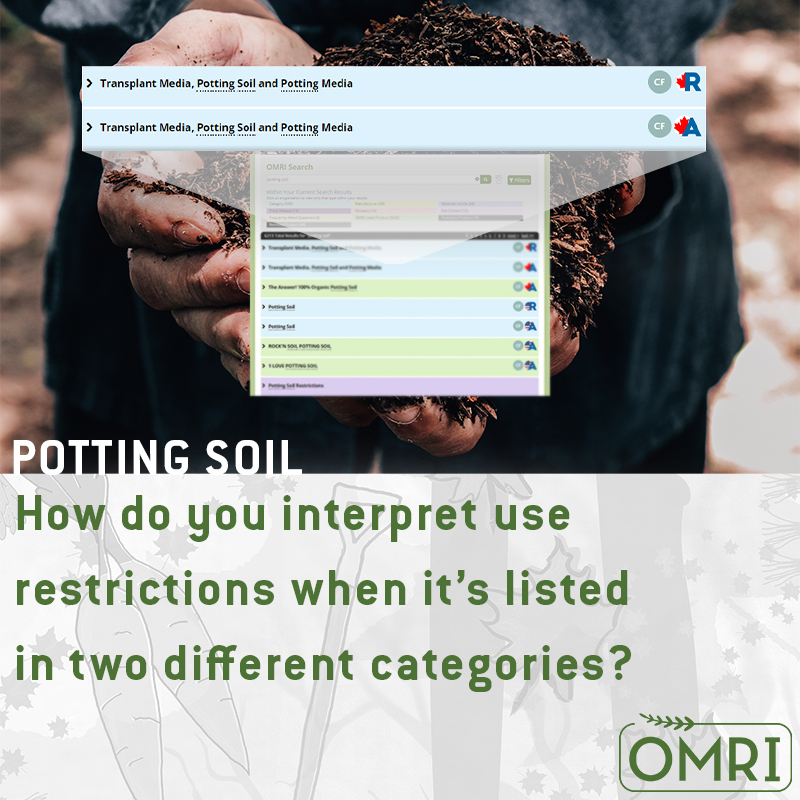Potting Soil Restrictions
 How can I interpret restrictions for a potting soil when it’s listed in two categories?
How can I interpret restrictions for a potting soil when it’s listed in two categories?
By Jennifer Christie
To organic producers and certifiers, an input’s OMRI Listed® seal and certificate indicate that the product has undergone a rigorous independent review process. Understanding how to interpret an OMRI Listed certificate is key to determining how products on the OMRI Products List may be used in compliance with the organic regulations. This article focuses on a question specific to the OMRI Canada Products List, but the concepts also apply to products listed to the USDA National Organic Program standards and the Mexico Organic Products Law.
The Canadian Organic Standards describe the use of inputs within the General principles and management standards (CAN/CGSB 32.310). Permitted materials are divided by tables into various use classes, and most are further described on the Permitted Substances Lists (PSL), found in CAN/CGSB 32.311. OMRI’s categories are also organized by use class, and most categories are based on a specific material within a PSL table.
The OMRI Products List and OMRI Listed certificate communicate the specific use(s) for which a product has been approved, and any specific use restrictions that an end user must consider. An OMRI Listed product may appear in one or more categories, depending upon the material or blend of materials. Sometimes a product is listed in multiple categories because the applicant requested and paid for reviews to additional categories; this can be a marketing decision, allowing the product to appear in more places in the OMRI Products List. A product listed in multiple categories will also appear in more search results on the OMRI.org website. In other cases, OMRI staff will add an additional category at no cost, in order to convey the necessary restrictions.
For example, let’s say a manufacturer applied to have their potting soil added to the OMRI Canada Products List under the Category: Transplant Media, Potting Soil and Potting Media. The formulation includes coconut coir, perlite, mined limestone, composted manure and alfalfa meal. PSL Table 4.2 (Substances for crop production) includes an entry for “Transplant media, potting soil and potting media.” It requires that all ingredients in a potting soil must also appear separately on the PSL table. In this example, OMRI confirmed that all of the ingredients conformed to their PSL Table 4.2 annotations.
Some material annotations carry specific use restrictions, as is the case for “Alfalfa meal and pellets.” According to the regulations, organic producers should first try to source organic alfalfa products, if commercially available. In our example, the product’s alfalfa ingredient was not organic (or staff was unable to confirm the certified organic status), so a commercial availability restriction needs to be applied. OMRI staff added a second category in order to convey the restriction, and the potting soil was listed as Allowed with Restrictions in the Categories: Transplant Media, Potting Soil and Potting Media; Alfalfa Meal or Pellets (non-Organic); Class: Crop Fertilizers and Soil Amendments. An organic farmer reading the product’s OMRI Listed certificate would confirm whether an alternative product containing certified organic alfalfa meal is available for purchase, and would document that search for review by their certifier. The restricted product would be compliant for use only if those alternatives are not commercially available.
This article was originally published in the fall 2021 edition of the OMRI Materials Review Newsletter, and was revised in March 2022 by Senior Bilingual Technical Coordinator Tina Jensen Augustine.








